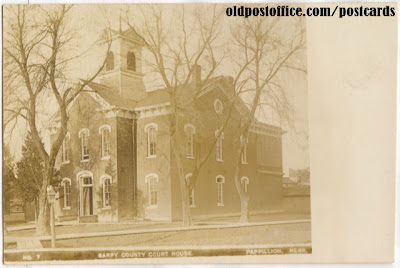
Construction of the Frank House at Kearney, NE begain in 1886 and was completed in 1889. Built by George Washington Frank the house is made of red Colorado sandstone, with English golden oak interior paneling and lumber, and handcarved woodwork and had ten fireplaces (six remain today). Ten years after Edison invented the light bulb, the house would be the first house west of the Mississippi to be wired for electric lights during construction. The house even features a 5' x 10' Tiffany window. Other modern conveniences in the house included two bathrooms, steam heating, built-in closets (20 of them), and servants quarters. George's son, George William Frank, Jr. designed the house for his parents based on the H.H. Richardson Romanesque Shingle style.
George Washington Frank was born in New York state in 1830. Prior to his arrival to Kearney in 1885, he had been a partner in a bank in Corning, Iowa. After his arrival in Kearney, Mr. Frank began a major role in the development of the city. As president of the Frank Improvement Company, his projects included completion of the Kearney Canal, an electric power plant, and an electric railway system. The house was constructed to entertain Eastern capitalists for these industrial interests.
George first came to the Kearney area in 1871 or 1872 on a business trip where he purchased 1042 acres of land from the Union Pacific railroad. He had first heard about the area from his cousin, Col. W.W. Patterson, an employee of the C.B. & Q. railroad who was charged to locate a suitable place to create a junction between the C.B. & Q. and the Union Pacific RRs. Col. Patterson surmised that the Platte River and its underground water supplies could be used to create electrical power and irrigated farming lands. Patterson along with the other founding fathers of Kearney formulated the plan and began work on the Kearney Canal. George Frank invested in what became the Kearney Canal in 1885, purchasing 80% of the companies stock. His company completed construction of the canal in 1886. The opening of the canal allowed Kearney to be transformed from the desolate prairie and small fort that George had seen in 1871/72 to a booming industrial town with over 100 manufacturers. The George W. Frank Improvement Company ran the power plant and canal and an electric street car system.
The depression and financial panic of 1893 followed by a drought in 1894 bankrupted the Franks and much of the industry in Kearney. George Sr. now in his seventies and in poor health lost his fortune and his assets were divided among his investors. Phoebe died in February of 1900 at the age of 68. George moved in with family in Lincoln, NE, where he died in 1906 at the age of 76.
The Franks lived in the house from 1890 to 1900. After the Franks, the house was owned by Dr. Grothan who operated a private sanitarium in the house. In 1907 the house was sold to the State and was accessioned to be part of the Nebraska Tuberculosis hospital. The house was used as quarters for the TB hospital staff until the hospital closed in 1971. At that time, the buildings were transferred to Kearney State College and restoration of the house began. It was placed on the National Register of Historic Places in 1973. The house is open for tours during certain times of the year. Go here for more info.




